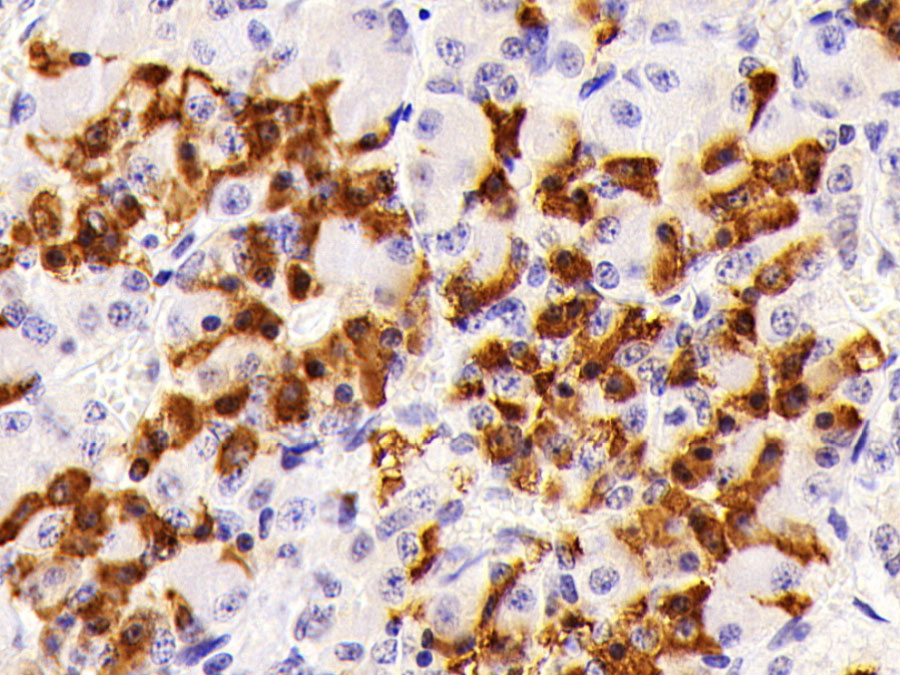Biotin-Linked Polyclonal Antibody to Prolactin (PRL) 

LTH; Luteotropic Hormone
Overview
Properties
- Product No.LAA846Hu71
- Organism SpeciesHomo sapiens (Human) Same name, Different species.
- ApplicationsIHCIf the antibody is used in flow cytometry, please check FCM antibodies.
Research use only - Downloadn/a
- CategoryEndocrinologyReproductive scienceGenetic scienceHormone metabolism
- SourceAntibody labeling
- Ig Type IgG, Potency n/a
- PurificationAntigen-specific affinity chromatography followed by Protein A affinity chromatography
- LabelBiotin
- Original Antibody n/a
- Buffer FormulationPBS, pH7.4, containing 0.01% SKL, 1mM DTT, 5% Trehalose and Proclin300.
- TraitsLiquid, Concentration 500µg/mL
Sign into your account
Share a new citation as an author
Upload your experimental result
Review

Contact us
Please fill in the blank.
Specifity
The antibody is a rabbit polyclonal antibody raised against PRL. It has been selected for its ability to recognize PRL in immunohistochemical staining and western blotting.
Usage
Western blotting: 0.2-2µg/mL;1:250-2500
Immunohistochemistry: 5-20µg/mL;1:25-100
Immunocytochemistry: 5-20µg/mL;1:25-100
Optimal working dilutions must be determined by end user.
Storage
Store at 4°C for frequent use. Stored at -20°C in a manual defrost freezer for two year without detectable loss of activity. Avoid repeated freeze-thaw cycles.
Stability
The thermal stability is described by the loss rate. The loss rate was determined by accelerated thermal degradation test, that is, incubate the protein at 37°C for 48h, and no obvious degradation and precipitation were observed. The loss rate is less than 5% within the expiration date under appropriate storage condition.
Organism Species More: Sus scrofa; Porcine (Pig)Giveaways
Increment services
-
 Protein A/G Purification Column
Protein A/G Purification Column
-
 Staining Solution for Cells and Tissue
Staining Solution for Cells and Tissue
-
 Positive Control for Antibody
Positive Control for Antibody
-
 Tissue/Sections Customized Service
Tissue/Sections Customized Service
-
 Phosphorylated Antibody Customized Service
Phosphorylated Antibody Customized Service
-
 Western Blot (WB) Experiment Service
Western Blot (WB) Experiment Service
-
 Immunohistochemistry (IHC) Experiment Service
Immunohistochemistry (IHC) Experiment Service
-
 Immunocytochemistry (ICC) Experiment Service
Immunocytochemistry (ICC) Experiment Service
-
 Flow Cytometry (FCM) Experiment Service
Flow Cytometry (FCM) Experiment Service
-
 Immunoprecipitation (IP) Experiment Service
Immunoprecipitation (IP) Experiment Service
-
 Immunofluorescence (IF) Experiment Service
Immunofluorescence (IF) Experiment Service
-
 Buffer
Buffer
-
 DAB Chromogen Kit
DAB Chromogen Kit
-
 SABC Kit
SABC Kit
-
 Real Time PCR Experimental Service
Real Time PCR Experimental Service
Citations
- In Vivo Evidence for Epidermal Growth Factor Receptor (EGFR)-mediated Release of Prolactin from the Pituitary GlandJcb: 39297
- TLR9 expression is associated with prognosis in patients with glioblastoma multiformeScienceDirect: S0967586811003572
- Determination of prolactin hormone in serum and urine using an electrochemical immunosensor based on poly(pyrrolepropionic acid)/carbon nanotubes hybrid modified electrodesSciencedirect:S0925400514000720
- Effect of extended photoperiod during winter on growth and onset of puberty in Murrah buffalo heifersPubmed:27051212
- Effect of thermal stress on physiological, hormonal and haematological parameters in Tharparkar and Karan Fries calvespublication:306322503
- Differentiation of human umbilical cord Wharton’s jelly-derived mesenchymal stem cells into endometrial cellspubmed:29096715
- The role of mesenchymal stem cells in chemotherapy-induced gonadotoxicityPubmed:30021657
- Impact of Triclosan on Female Reproduction through Reducing Thyroid Hormones to Suppress Hypothalamic Kisspeptin Neurons in MicePubmed:29403355
- The antipsychotics sulpiride induces fatty liver in rats via phosphorylation of insulin receptor substrate-1 at Serine 307-mediated adipose tissue insulin resistancePubmed:29551354
- The prolactin‐release inhibitor paeoniflorin suppresses proliferation and induces apoptosis in prolactinoma cells via the mitochondria‐dependent pathwayPubmed:29388711
- Metformin inhibits growth and prolactin secretion of pituitary prolactinoma cells and xenograftsPubmed: 30334324
- Hormonal and metabolic indicators before and after farrowing in sows affected with postpartum dysgalactia syndromePubmed: 30404636
- Expression of prolactin receptors in the duodenum, kidneys and skeletal system during physiological and sulpiride-induced hyperprolactinaemiaPubmed: 30143940
- Morphological and Biochemical Characteristics of Prostate Hyperplasia during Sulpiride TreatmentPubmed: 32152847
- Effect of heat stress during the early and late dry period on mammary gland development of Holstein dairy cattlePubmed: 32684470
- Pathophysiological Changes in Female Rats with Estrous Cycle Disorder Induced by Long-Term Heat StressPubmed: 32685488
- Prolactin affects the disappearance of ALV-J viremia in vivo and inhibits viral infection34391195
- Effects of a Nanoencapsulated Moringa Leaf Ethanolic Extract on the Physiology, Metabolism and Reproductive Performance of Rabbit Does during Summer34439574
- Yogurt Enriched with Inulin Ameliorated Reproductive Functions and Regulated Gut Microbiota in Dehydroepiandrosterone-Induced Polycystic Ovary Syndrome MicePubmed:35057459






